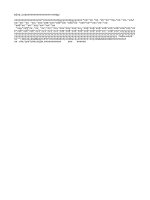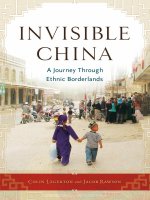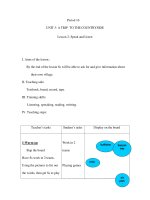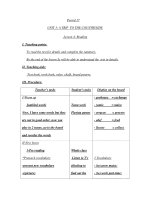a trip through panama
Bạn đang xem bản rút gọn của tài liệu. Xem và tải ngay bản đầy đủ của tài liệu tại đây (31.23 KB, 2 trang )
Day 1: We arrived at Omar Torrijos airport via American Airlines
early in the afternoon. We purchased our required tourist cards (3
balboas, as US dollars are called in Panama) at the airport, then caught a
taxi for the 18 mile ride to our downtown hotel. The ride in the battered,
un-airconditioned car was rather expensive (30 balboas), but the driver
spoke English and was very friendly. We arrived at the hotel and
checked in. While my dad was checking in I bought a guidebook in the
hotel lobby and read up on the history of Panama City. The original city
was founded in 1519 by Pedro Arias Davila, known as Pedrarias the
Cruel, because of his eradication of all but three of the local Indian tribes
during his tenure in Panama. Davila used the city as a place to store
Incan gold before it was shipped to Spain. The original city was sacked
and burned in 1671 by a group of buccaneers led by Henry Morgan. The
city was rebuilt within a year, this time on a peninsula 18 miles away and
surrounded by a strong wall. This old Spanish city is now the in the
middle downtown Panama City. Panama City is an international melting
pot and its eating choices range from American fast food to excellent
internationall cuisine. Eager to begin our sightseeing, we grabbed lunch
at a nearby McDonald's after checking in then caught a bus. The buses
in Panama are a tourist attraction in themselves. They are brightly
painted, hung with fringe, and have constantly blaring Salsa and Caracas
music playing. They are cheap (50 cents a ride). but are very crowded.
After asking several drivers "Donde va este autobus?" we finally found
one going to the Plaza Independencia. This plaza is the main square of
the colonial town and is bordered on one side by a cathedral with twin
mother of pearl towers that took 108 years to complete. On two other
sides it is bordered by the Archbishop's Palace, now a university and the
Central Post Office. While in the old part of Panama City we also visited
the Iglesia de San Jose and saw the Golden Aaltar. This altar was in the
original Panama City and was saved from Henry Morgan's pirates by a
monk who painted it black to disguise it. When we finished touring we
returned to our hotel and then ate dinner at El Pez de Ora, one of the city'
famous seafood restaurants.Day 2: We woke early and headed out
for a morning of shopping at the Mercado Publico. I bought some jewelry
and some small wooden figurines as souvenirs, but when I asked "Donde
esta los sombreros de Panama?", the vendor told me Panama hats were
made in Ecuador. The hat most commonly worn in Panama is the "pita",
a narrow brimmed straw hat with black and white stripes. The most
important phrases to remember when shopping in Panama are " Cuanto
cuesta esta?" and " Acceptas tarjetas de credita?" After shopping we had
Chinese food in one of the local restaurants. After eating we went to
visit Panama's most famous attraction, the Panama Canal. The Canal
was completed in 1914, and is considered one of the greatest
engineering feats in the world. We took a shuttle from our hotel to the
canal and then went on a 90 minute train ride all the way across the
isthmus along the canal. The railroad we were traveling on was built in
1855 to transport '49ers who were on their way to the California gold rush
and was the first "trans-continental" rail link. At one of the train stations
we got off and walked to the Miraflores Locks, sat on bleachers, and
watched the ships go through the canal. After our tour of the Panama
Canal we returned to our hotel to get ready for a night of dinner and
theater. We ate dinner at an Italian restaurant then went to the Teatro
National for a performance of the Folkloric Ballet. The Folkloric Ballet
features native folk dances and costumes and was very entertaining. Day
3: We rented a car and left Panama City headed southwest along the
Pan American Highway. First we visited the Parque Natural
Metropolitana, a zoo on the outskirts of Panama with monkeys, deer,
sloths, and iguanas. We then drove toward El Valle, about 75 miles
away. El Valle is located in the center of a dormant volcano. There we
saw hot springs, botanical gardens (with square trees which scientists
have been unable to explain!), and golden frogs found nowhere else on
earth. We continued down the highway passing through the towns of
Penonome, the geographic center of Panama, and Nata, on of the oldest
towns in Latin America. The Interior of Panama is mostly farmland and
grazing land for cattle. We even saw some cowboys! At night we arrived
at Baquette, a village on the side of the dormant Baru Volcano, where we
spent the night. Day 4:We began our day by visiting Volcan Baru
National Park and taking a short hike to see the beautiful plants and
birds. The volcano is the highest point in Panama at 3475 meters. After
our hike we ate lunch and then drove to Chiriqui Grande where we
dropped off our car. We then caught a ferry to Bocas del Toro where we
visited Bastimentos National Park. The park has pristine white sand
beaches where sea turtles nest. The coral reefs off the coast are home
to more than 200 species of tropical fish. While there we also got to visit
caves containing the largest population of fruit eating bats in the world!
Later we went snorkeling of the coast of Almirante Island where we spent
the night.









